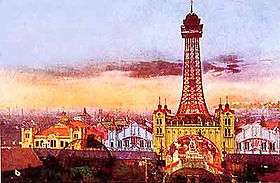Tsūtenkaku
Tsūtenkaku (通天閣, lit. "Tower Reaching Heaven"), owned by Tsūtenkaku Kanko Co., Ltd. (通天閣観光株式会社, Tsūtenkaku Kankō Kabushiki-gaisha), is a tower and well-known landmark of Osaka, Japan and advertises Hitachi. It is located in the Shinsekai district of Naniwa-ku, Osaka. Its total height is 103 m; the main observation deck is at a height of 91 m.

History

The current tower is the second to occupy the site. The original tower, patterned after the Eiffel Tower and the Arc de Triomphe, was built in 1912, and was connected to the adjacent amusement park, Luna Park, by an aerial cable car. At the time of its construction, its height of 64 meters made it the second tallest structure in Asia. It quickly became one of the most popular locations in the city, drawing visitors from all over the area. The original structure suffered a fire in 1943 which severely damaged it, and rather than repair the structure, it was disassembled and the steel used for the war effort.[1]
After the war, citizens lobbied to rebuild the beloved tower. A private company, the Tsūtenkaku Kanko Co. Ltd. was established and Tachū Naitō, Japan's "Father of Towers" was selected to design it. The new, eight-sided structure was opened in 1956.[2]
On the fifth floor observation deck is enshrined Billiken, the God of Happiness or "things as they ought to be". Billiken, a popular American charm doll that came to Japan in about 1910, was enshrined within Luna Park when it opened. When the park closed in 1923, the wooden statue of Billiken went missing. As a part of an effort to revive the tower, a copy of Billiken was made from an old photograph and placed inside the tower in 1979. The statue of Billiken became closely associated with the tower and is a popular symbol of good luck. Each year thousands of visitors place a coin in his donation box and rub the soles of his feet to make their wishes come true.
The tower is also famous for its neon lights, which change every few years (they were shut off during the oil crisis of 1974–76). The neon lights have now been replaced by LED lighting, showing a different color set for every two months (e.g. pink for cherry blossom in March/April). Hitachi has sponsored the tower since 1957, and the light designs usually spell out Hitachi advertisements, although one side of the tower is usually occupied by a public service announcement. The lights on top of the tower show tomorrow's weather by a combination of different colors.
 Fire damage to the original Tsutenkaku tower in 1943
Fire damage to the original Tsutenkaku tower in 1943 Demolition of the first Tsutenkaku Tower
Demolition of the first Tsutenkaku Tower
Access
- JR West, Osaka Loop Line and Yamatoji Line, Shin-Imamiya Station, East Exit (10-minute walk)
- Nankai Railway, Nankai Main Line and Koya Line, Shin-Imamiya Station, East Exit (10-minute walk)
- Osaka Municipal Subway Sakaisuji Line (brown line), Ebisuchō Station, Exit 3 (3-minute walk)
- Osaka Municipal Subway Midosuji Line (red line), Dobutsuen-mae Station, Exit 5 (10-minute walk)
- Hankai Tramway, Hankai Line, Ebisucho Station (3-minute walk)
References
- "Tsūtenkaku". City of Osaka Recreation and Tourism Bureau. Archived from the original on 17 May 2010. Retrieved 27 June 2010.
- Tegler, Gary. "Osaka's spirit in the sky". The Japan Times. Retrieved 27 June 2010.